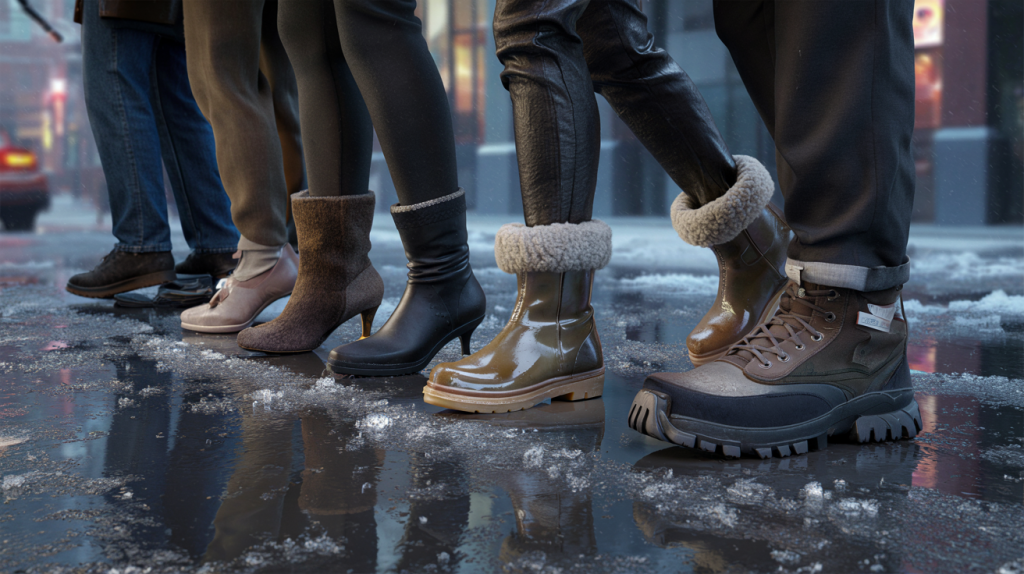Winter boots look protective by default. Yet the wrong pair quietly ramps up pain, blisters, fungal flare ups and even falls on slick pavements. According to the American Podiatric Medical Association 2014 survey, 77 percent of adults reported foot pain, and about half said it limited activity. Cold and moisture magnify all of that. People lace up, then wonder why a short walk feels like a marathon.
The culprits are not only sky high heels. Narrow fashion boots that pinch, rubber styles that trap sweat, smooth soles that skid and floppy shearling icons with zero support all add risk. Add diabetes into the picture and the stakes rise fast. The CDC estimated 37.3 million Americans were living with diabetes in 2022, a group more vulnerable to numbness, skin breakdown and wounds that heal slowly. Choosing the wrong winter shoe is not a style miss. It is a health problem waiting to happen.
Winter foot health : what goes wrong and why
Cold constricts blood flow. That reduces cushioning and sensation, so small pressure points turn into big pain quickly. When linings keep sweat in, skin stays damp, and friction climbs. The British Association of Dermatologists reports that athlete’s foot can affect up to 15 percent of people at any one time, a risk that grows when shoes stay wet inside.
Fit is the next trap. Foot volume changes across the day and in the cold, and thick socks can crowd toes without anyone noticing. A tight toe box compresses nerves and increases forefoot pressure with every step. For people with diabetes or neuropathy, that pressure may not be felt until damage has already occured.
Grip makes or breaks a winter commute. Minimal tread and hardened outsoles slide on packed snow and painted crosswalks. Even a short detour to the bus stop is enough to test balance if the sole cannot bite into grit and ice.
The winter shoes to avoid right now
Some pairs look cozy, but they quietly work against foot health, especially in cold, wet weeks. Here is what to sidestep when temperatures drop :
- High heeled boots that shift weight into the forefoot and shorten calf muscles
- Flat shearling boots with soft, unsupportive midsoles that let arches collapse
- Rubber rain boots used as snow boots, with no insulation or breathability
- Narrow, pointy toe fashion boots that squeeze toes and irritate nerves
- Old sneakers or boots with smooth, worn soles that lose traction on wet tile and ice
- Oversized boots stuffed with thick socks that let heels lift and rub blisters
- Heavy mountaineering style boots for city walking that fatigue ankles and hips
Real world evidence : moisture, pressure and slips add up
Moisture is a quiet accelerator. Lined winter shoes feel warm at first, then lock in sweat on the commute home. Persistent dampness softens skin and invites fungus. That is why podiatry clinics see more maceration and cracking in cold months than in July.
Pressure tells a similar story. Heels and tight forefeet elevate load under the ball of the foot. Over weeks, that can inflame the big toe joint, irritate nerves between toes and wake up bunion pain. The APMA survey from 2014 also found many adults link shoe choices to back and knee discomfort, a ripple effect that shows up fast once sidewalks turn icy and strides shorten.
Slips do not only happen on black ice. Painted lobby floors, subway steps and polished mall tiles become slick when salt and meltwater mix. Minimal tread struggles there, which is why safety bodies test soles on wet and oily surfaces and encourage slip resistant patterns with deeper lugs and softer compounds that stay grippy in the cold.
Safer winter picks : how to protect feet without giving up style
Look for a roomy, round toe box that lets toes spread, especially with a thicker sock. Try on late in the day, standing, with the socks actually worn outside. There should be a thumb nail of space in front of the longest toe, and the heel should feel locked without rubbing.
Choose a supportive midsole and a firm counter around the heel. A removable insole lets custom or over the counter orthotics sit flat. If arches collapse in soft boots, swap in a structured insole to keep the foot neutral on long days.
Prioritize waterproof and breathable uppers, not just rubber. Leather or synthetics with a membrane keep slush out and let vapor escape. After wear, pull out insoles and let shoes dry at room temperature for a full day. Rotating pairs cuts the risk of persistent dampness and odor.
For traction, examine the outsole. Look for deep, multi directional lugs and a rubber that stays flexible in the cold. On very icy weeks, clip on purpose built traction devices while outdoors, then remove them indoors to avoid slips on hard floors.
For anyone with diabetes or reduced sensation, insulation that keeps toes warm, a gentle wool sock and a protected, seamless interior are not optional. Inspect feet daily. If redness, blistering, cracks or color changes appear, pause the shoe and contact a healthcare professional promptly.
